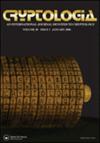Leo Marks的“一次性密码簿”:二战期间英国特种作战的一种实验性密码
IF 0.4
4区 工程技术
Q4 COMPUTER SCIENCE, THEORY & METHODS
引用次数: 0
摘要
摘要第二次世界大战期间,Leo Marks为英国特种作战署(SOE)设计了密码。马克斯的任务是确保SOE卧底特工能够加密从纳粹占领的欧洲到英国总部的无线电传输,他引入了一次性的pad密码,将随机密钥打印在纸和丝绸等材料上。然而,携带这些材料对特工来说是有风险的。为了降低这种风险,马克斯试验了一种他称之为“心智一次性密码”(MOP)的密码系统。与它的名字相反,MOP密码不是一个真正的一次性输入系统,而是使用双列换位和记忆文本来创建唯一的替换密钥。在本文中,我们将探讨MOP密码的设计、漏洞和历史意义,并讨论美国陆军密码学家William Friedman的潜在改进。关键词:Leo Marksmental一次性垫(MOP)换位替换密码william friedman二战密码披露声明作者未报告潜在的利益冲突。thomas Larsen是澳大利亚商业领域的数据科学家,同时在墨尔本大学和莫纳什大学从事重症监护研究。他擅长于精确和可解释(A+I)的机器学习技术,包括符号回归。本文章由计算机程序翻译,如有差异,请以英文原文为准。
Leo Marks’ “mental one-time pad”: an experimental cipher for British special operations in World War II
AbstractDuring World War II, Leo Marks designed ciphers for the British Special Operations Executive (SOE). Tasked with ensuring that SOE undercover agents could encrypt radio transmissions from Nazi-occupied Europe to British headquarters, Marks introduced one-time pad ciphers with random keys printed on materials like paper and silk. However, carrying such materials was risky for agents. In an attempt to mitigate this risk, Marks experimented with a system he called the “Mental One-Time Pad” (MOP) cipher. Contrary to its name, the MOP cipher was not a genuine one-time pad system, but rather used double columnar transposition with memorized texts to create unique substitution keys. In this article, we’ll explore the design, vulnerabilities, and historical significance of the MOP cipher, and discuss potential improvements from US Army cryptographer William Friedman.Keywords: Leo Marksmental one-time pad (MOP)transposition-substitution ciphersWilliam FriedmanWorld War II ciphers Disclosure statementNo potential conflict of interest was reported by the authors.Additional informationNotes on contributorsThomas LarsenThomas Larsen is an Australian data scientist in the commercial sector as well as in critical care research at the University of Melbourne and Monash University. He specializes in accurate and interpretable (A+I) machine learning techniques including symbolic regression.
求助全文
通过发布文献求助,成功后即可免费获取论文全文。
去求助
来源期刊

Cryptologia
工程技术-计算机:理论方法
自引率
33.30%
发文量
31
审稿时长
24 months
期刊介绍:
Cryptologia is the only scholarly journal in the world dealing with the history, the technology, and the effect of the most important form of intelligence in the world today - communications intelligence. It fosters the study of all aspects of cryptology -- technical as well as historical and cultural. The journal"s articles have broken many new paths in intelligence history. They have told for the first time how a special agency prepared information from codebreaking for President Roosevelt, have described the ciphers of Lewis Carroll, revealed details of Hermann Goering"s wiretapping agency, published memoirs - written for it -- of some World War II American codebreakers, disclosed how American codebreaking affected the structure of the United Nations.
 求助内容:
求助内容: 应助结果提醒方式:
应助结果提醒方式:


